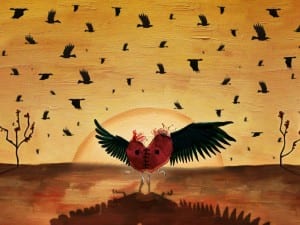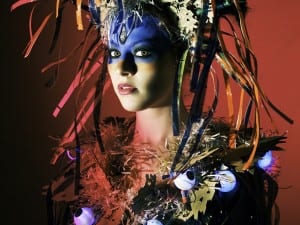Text by Bethany Rex
Helen Carmel Benigson (b.1985) is media-savy that is for sure; her work layers colour, print and sound to create immersive, dreamlike and hyper-sensual installations that explore the politics of sexual difference and female empowerment. Benigson looks at the nature of identity, performance and masquerade, and her latest exhibition at the James Hockey & Foyer Galleries at the University for the Creative Arts (UCA) at Farnham is her largest exhibition to date.
Working in a range of media, Benigson’s work is described as a “collision of all things sexy, cool and current.” That’s quite a big claim for someone who cites The Hills and the Kardashians as inspiration. Still, through her continuous reference to virtual reality, the concept of the alter-ego and the advent of the online profile (Benigson often performs as LA-born rapper Princess Belsize Dollar) Benigson reminds the viewer of the difference between the real and the virtual, and of the dangers and consequences of each type of existence. These are all important borders to explore.
Comparisons to Swiss artist Pipilotti Rist are understandable; saturated colours, psychedelic patterns, a palette that teeters on the border between provocation and parody, it remains to be seen, however, whether Benigson’s delight in the dangerous and provocative is matched with a craft that is considered and a narrative that extends beyond 140 characters. We caught up with the artist named by The Independent as a potential successor to Tracey Emin to explore the truth beyond the fiction, maybe.
BR: Could you talk us briefly through your background? When did you first start making work?
HCB: I have just completed my MA at the Slade. I grew up in London and have been making art from an early age, although made my first video, at the age of 18, when I interviewed a butcher.
BR: When did Princess Belsize Dollar come into being? What does she represent?
HCB: PBD is a rapper, born in LA. She stands for a feminine, super-sexy activist who performs as a version of myself as well as a completely severe alternative.
BR: As an artist, you are often described as provocative. Do you feel this is an apt description of your practice?
HCB: 1% provocative, 99% evocative. Obviously my work borders on spaces of contention, such as the locations I choose to make work in, as well as making work about bodies. I am interested in the space of occupation / conflict and yes – provoking something harder / more intense / imaginative.
BR: Reading about your alter egos, it’s overwhelming. Could you briefly talk us through all these different versions of yourself?
HCB: There is my cousin, who is me, but not quite me, in that she looks like me, but not quite and lives in Switzerland so Swiss-German is her first language, although English is her mother-tongue. I also create avatars, who look similar to both of us. Then, there is PBD, a super-sexy, sweet version of myself. I am also now working with dancers, who do not look anything like me, but all stand in for me within the context of the videos. Identity is continually being framed and re-framed within the videos, sound and installations.
BR: What is it about the boundaries of cyberspace, and this idea of identity in different territories that captures your interest?
HCB: My practice is situated in a space that both replicates and borrows gestures and symbols from cyberspace and reworks them in a way that becomes a framework for the body and identity. There is now a new space to work about and in – that of online and cyber. My work is concerned with biology and technology and how new currents of information and communications are changing. This can be seen is our own schizophrenic performances on a daily basis.
BR: What work have you prepared for the exhibition at UCA Farnham?
HCB: I am making 8, 10 and 15 foot polystyrene palm trees that will become screens as I project videos onto them. I am creating a sort of faux-beach space, filled with real sand, the palm trees, enlarged beach-balls, deckchairs and a huge cinema screen. Visitors can come into the space, relax on the beach chairs and watch the films. I have also made a new film, set in the sand dunes in South Africa and at a poker game. This film, will form a section of a new, more extended film that I am working on to do with insomnia, poker and sleep-talking . At the opening of this exhibition, I will be rapping with my musical collaborator, Helen Bellringer. There will also be live poker games. Boys are invited to play poker, using my own customised playing cards and poker chips.
BR: How do you consider the interplay between photography and the more conceptual pieces in the context of this show?
HCB: I think about all the works, as sculptural objects and the relationship between the objects and the body. Much of photography comes from the videos. The videos work as a series of still prints, and I enjoy the idea of being able to print every image from the video and turn it into an object. In this show, most of the photography is in the Foyer gallery and the beach installation is in the James Hockey gallery, so there is not a physical relationship between the two.
BR: Are there any photographers or artists or just people from everyday life that have inspired the project?
HCB: Yes, Yto Barrada, made lots of work about palm trees, that I really like. I have just come back from LA and Cape Town, where every street is lined with palm trees and that has inspired it too. I recently saw Ryan Trecartin’s show in Paris, which was amazing and also Phyllida Barlow’s recent show at Hauser and Wirth – in her work there is a sort of fake monumentalism, which I completely relate to. Pipilotti’s Rist’s recent show at Hayward was also brilliant. I have been re-watching a lot of Entourage, set in LA, so that has also influenced me, I am sure, if only subliminally.
BR: Your work is often described as breaking such borders as those between the self and the world; art and life, and other dichotomies we are all too familiar with. I feel as those these boundaries were broken long ago. Do you bring something new to this ongoing discussion?
HCB: I feel that my practice both acknowledges and contests the limits of these boundaries. I am interested in the limit of something as a space in itself. I don’t think my work sets out to address the borders between self and the world, or art and life, although obviously identity within territory is a concern. I think there is a big difference between presenting dichotomies, which I don’t aim to do, and performing occupation, which I hope my videos begin to do.
Helen Carmel Benigson: Palm Trees and Poker Players, Curated by Christine Kapteijn MA(RCA) MBA, 27/01/2012 – 17/03/2012, James Hockey & Foyer Galleries, UCA Farnham. www.ucreative.ac.uk/galleries Helen Carmel Benigson is represented by ROLLO Contemporary Art
Aesthetica in Print
If you only read Aesthetica online, you’re missing out. The February/March issue of Aesthetica is out now and offers a diverse range of features from an examination of the diversity and complexity of art produced during the tumultuous decade of the 1980s in Art, Love & Politics in the 1980s, opening 11 February at MCA Chiacgo, a photographic presentation of the Irish Museum of Modern Art‘s latest opening, Conversations: Photography from the Bank of America Collection. Plus, we recount the story of British design in relation to a comprehensive exhibition opening this spring at the V&A.
If you would like to buy this issue, you can search for your nearest stockist here. Better yet call +44 (0) 1904 629 137 or visit the website to subscribe to Aesthetica for a year and save 20% on the printed magazine.





